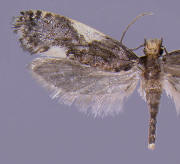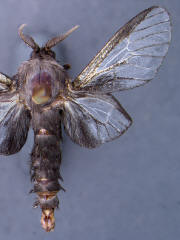|
Family Tineidae, Cloths moths and allies can be
recognized by the single whorl of scales on each antennal flagellomere. The
maxillary palpi are usually folded over the base of the proboscis. There are
3,000 species world wide and at least 113 in North America. |


Monopis spilotella Tengstrõm (left),
Xylesthia pruniramiella (right)
|
|

Antenna of tineid showing one whorl of scales per segment.
|

Antenna of acrolophid showing two whorls of scales per segment.
|
|

Long, folded maxillary palpi |

Minute, straight maxillary palpi |
|
Family
Acrolophidae, Burrowing
webworms can be recognized by the double whorl of scales on each antennal
flagellomere. The maxillary palpi are greatly reduced or absent and labial
palpi are usually long and often recurved over the vertex. There are 250
species in this New World family, 51 of which occur in North America.
|


Amydria sp. (left), Acrolophus sp.(right) |
| |
|
| Family Psychidae,
Bagworm moths, are very diverse morphologically. Adult males can be
triangular winged and without tibial spurs, or rectangular winged and
similar to Tineidae. Usually, each antennal flagellomere has two whorls of
scales. Psychids always have the media stem present on both wings and
atrophied nonfunctional mouthparts. There are 600 species worldwide and 26
in North America. |


Thyridopteryx ephemeraeformis (Haworth) (left)
Dahlica walshella (Clemens) (right) photo courtesy of Jim VargoÓ
|
| |
|
